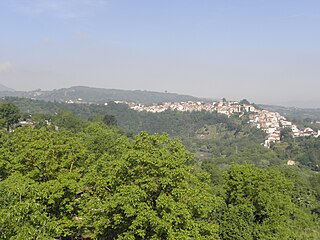
Avellino is a town and comune, capital of the province of Avellino in the Campania region of southern Italy. It is situated in a plain surrounded by mountains 47 kilometres (29 mi) east of Naples and is an important hub on the road from Salerno to Benevento.

The province of Avellino is a province in the Campania region of Italy. Its capital is the city of Avellino. The area is characterized by numerous small towns and villages scattered across the province; only two towns have a population over 20,000.

Savignano Irpino is a village and comune in the province of Avellino, in the Campania region of southern Italy.

Gesualdo is an Italian town in the province of Avellino, itself in the region of Campania. It is called "The city of the Prince of Musicians" in honour of Carlo Gesualdo. It has many palaces, fountains, belvederes, and a historical center, which was partially restored after the Irpinia earthquake in 1980.

Bonito is a comune in the Province of Avellino, in the Region of Campania, Italy. Located in the southern Apennines upon a rounded knoll, it overlooks the Ufita Valley within the historical district of Irpinia.

Pagani is a town and comune in Campania, Italy, administratively part of the Province of Salerno, in the region known as the Agro nocerino-sarnese. Pagani has a population of 35,834, as of 2016.

Nusco is a town and comune in the province of Avellino in the south of Italy, east of Naples, with a population of around 4,100. It is situated in the mountains between the valleys of the Calore Irpino and Ofanto rivers. It is a member of the I Borghi più belli d'Italia association.
Lacedonia is a comune in the province of Avellino, Campania region, southern Italy, overlooking the Osento River which flows into the Lago di San Pietro, an artificial lake. The town is part of the Roman Catholic Diocese of Ariano Irpino-Lacedonia.

Aiello del Sabato is a town and comune in the province of Avellino, Campania, southern Italy. Its name derives from the Latin agellus and from the Sabato river, a tributary of the Calore Irpino.

Greci is an Arbëreshë town and comune in the province of Avellino, Campania, Italy, located about 100 km northeast of Naples and about 50 km southwest of Foggia. It is a mountain agricultural village lying astride the Apennines and represents the only existing linguistic minority in Campania; Arbereshe people have settled in Greci since the 15th century.

Lioni is a town and comune in the province of Avellino, Campania, southern Italy.

Teora is a small town and comune in the province of Avellino, in the Campania region of southern Italy.

Conza della Campania is a comune (municipality) and former Latin Catholic (arch)bishopric in the province of Avellino in the region of Campania in southern Italy.

Prata di Principato Ultra is a town and comune of the province of Avellino in the Campania region of southern Italy. The town spread along a hill on the left shore of the Sabato river. The place is mentioned for the first time in a historical document in 1070.
San Mango sul Calore is a village and comune in the province of Avellino, in the Campania region of southern Italy.

Summonte is a town and comune in the province of Avellino, Campania, Italy. It is a member of the I Borghi più belli d'Italia association.
Taurano is a village and comune in the province of Avellino, in the Campania region of southern Italy.

Zungoli is a town and comune in the province of Avellino, Campania, southern Italy, about 58 kilometres (36 mi) from the town of Avellino.

Giffoni Valle Piana, commonly known as Giffoni, is a town and comune in the Province of Salerno, Campania, southwestern Italy.

Accadia is a town and comune in the province of Foggia in the Apulia region of southeast Italy. Until the mid-20th century it was just within the eastern frontier of the region of Campania in the province of Avellino.





















